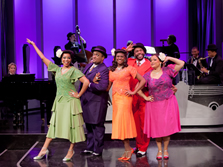The final concert of the season of the University of North Carolina Symphony Orchestra always brings out a large audience of student musicians’ extended families and friends as well as knowledgeable music lovers. The orchestra, under music director Tonu Kalam, fields one of the largest array of players in the area. Beasley-Curtis Auditorium in Memorial Hall resounded with Kalam’s imaginative selection of an early Verdi opera overture, a contemporary American work, and a richly romantic Franco-Belgian symphony.
The concert opened with the overture to Nabucco, the third opera by Giuseppe Verdi (1813-1901), which was premiered March 9, 1842. It makes use of themes heard throughout the opera including “Va pensiero,” the famous Act III chorus in the opera that became an anthem for the rising Italian nationalist movement.
Kalam led an idiomatic performance that balanced portentous mood and dramatic action. The low brass portrayed the solemn, choral-like melody that captures the theme of the opera, the steadfastness of the Hebrews in the face of persecution. The Hebrew chorus’ curse of Ismaele was vividly captured by the full orchestral outburst. The low strings, violas, cellos, and basses produced a rich, full sound and there were fine solos from trumpet and oboe.
The “Elegy for Orchestra” by John Corigliano (b.1938) was premiered by the San Francisco Symphony June 1, 1966, and was dedicated to Samuel Barber, reflecting Corigliano’s close identification with the neo-Romantic style. It was derived from the “Love Scene” in the score Corigliano wrote for Wallace Fey’s play Helen, a romance between 40-year-old Helen and 20-year-old Telemachus. The composer writes “the single slow tempo begins quickly with a key passage for paired flutes, builds during its course to two double forte climaxes for full orchestra, and finally subsides for a pianissimo close for strings and woodwinds.”
Kalam brought out some very expressive, refined string playing along with sensitive playing from the pairs of instrumentalists employed by Corigliano. These fine players were flutists Abbey Jean Bergman and Katherine Gora Combs, clarinetists Andrew Huang and Peter Streilein, and Nick Konz and Tony Bird, French horns (principal players listed first). A brief viola solo was played by Andrew Michie, and the harpist was Grace Monteleone. Besides elegiac string melodies there was a striking pairing of percussion with multiple loud Bartók-style pizzicatos by the double basses.
The focus of the concert was the challenging Symphony in D minor by César Franck (1822-90). It was a failure at its premiere on February 17, 1889, in a concert of the Société des Concerts du Conservatoire, Paris. Franck failed to network and market himself and, as an organist, was regarded as an outsider who was ignoring classical models. His use of an English horn in the second movement was regarded “unforgivable.” Franck brought extreme Wagnerian chromaticism to symphonic structure and used cyclical transformation of short themes. His experience as an organist (according to Robert Orledge in Charles Dutoit’s Montréal Decca recording) is reflected in “extended pedal points and chorale-like juxtaposition of regular phrases on strings, woodwinds, and brass.” It is in three movements: Lento: Allegro ma non troppo, Allegretto (combines Andante and Scherzo), and a festive Allegro non troppo finale.
Kalam led an intense and richly satisfying, stylish performance, with terrific response from his student musicians who played as if at the edge of their seats. The orchestra followed every twist and turn of Franck’s theme transformations. The balancing of the first movement’s conflict between two moods was excellent culminating in fiery affirmation. Superb playing by all the brass was set against full string textures. The second movement was breathtaking with the superb solos from harpist Monteleone and Katie Michalak, English horn. String pizzicatos were delightful. Everything was brought together for a blazing, joyful conclusion.











